remote start CADILLAC STS 2008 1.G Owner's Manual
[x] Cancel search | Manufacturer: CADILLAC, Model Year: 2008, Model line: STS, Model: CADILLAC STS 2008 1.GPages: 500, PDF Size: 5.81 MB
Page 365 of 500
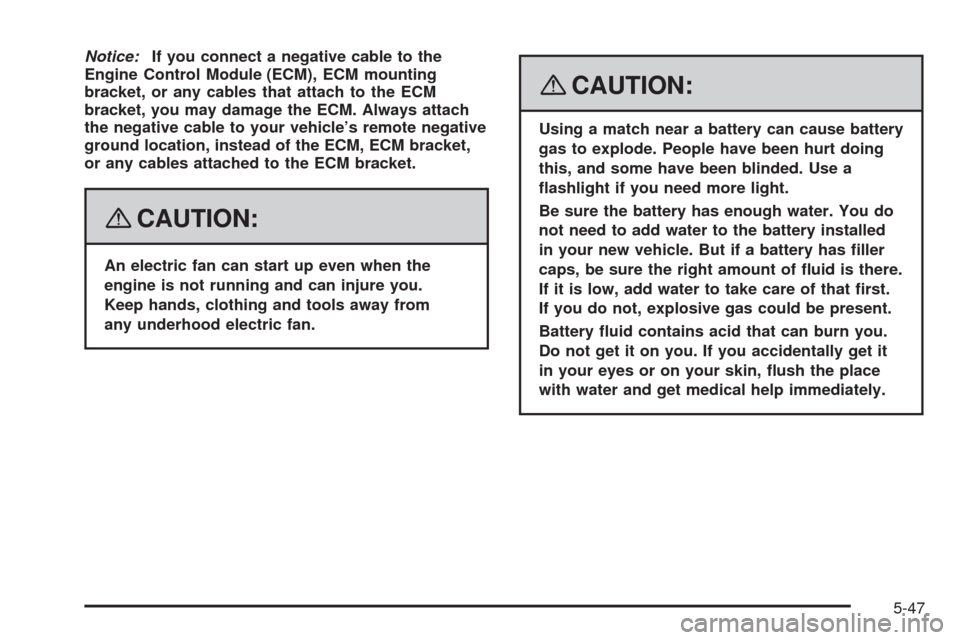
Notice:If you connect a negative cable to the
Engine Control Module (ECM), ECM mounting
bracket, or any cables that attach to the ECM
bracket, you may damage the ECM. Always attach
the negative cable to your vehicle’s remote negative
ground location, instead of the ECM, ECM bracket,
or any cables attached to the ECM bracket.
{CAUTION:
An electric fan can start up even when the
engine is not running and can injure you.
Keep hands, clothing and tools away from
any underhood electric fan.
{CAUTION:
Using a match near a battery can cause battery
gas to explode. People have been hurt doing
this, and some have been blinded. Use a
�ashlight if you need more light.
Be sure the battery has enough water. You do
not need to add water to the battery installed
in your new vehicle. But if a battery has �ller
caps, be sure the right amount of �uid is there.
If it is low, add water to take care of that �rst.
If you do not, explosive gas could be present.
Battery �uid contains acid that can burn you.
Do not get it on you. If you accidentally get it
in your eyes or on your skin, �ush the place
with water and get medical help immediately.
5-47
Page 367 of 500
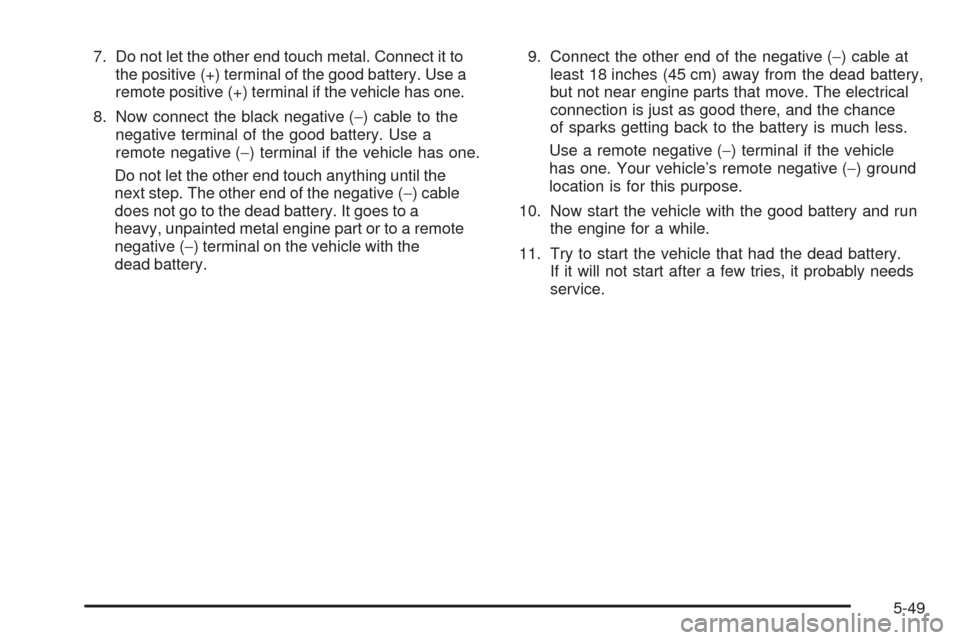
7. Do not let the other end touch metal. Connect it to
the positive (+) terminal of the good battery. Use a
remote positive (+) terminal if the vehicle has one.
8. Now connect the black negative (−) cable to the
negative terminal of the good battery. Use a
remote negative (−) terminal if the vehicle has one.
Do not let the other end touch anything until the
next step. The other end of the negative (−) cable
does not go to the dead battery. It goes to a
heavy, unpainted metal engine part or to a remote
negative (−) terminal on the vehicle with the
dead battery.9. Connect the other end of the negative (−) cable at
least 18 inches (45 cm) away from the dead battery,
but not near engine parts that move. The electrical
connection is just as good there, and the chance
of sparks getting back to the battery is much less.
Use a remote negative (−) terminal if the vehicle
has one. Your vehicle’s remote negative (−) ground
location is for this purpose.
10. Now start the vehicle with the good battery and run
the engine for a while.
11. Try to start the vehicle that had the dead battery.
If it will not start after a few tries, it probably needs
service.
5-49
Page 475 of 500
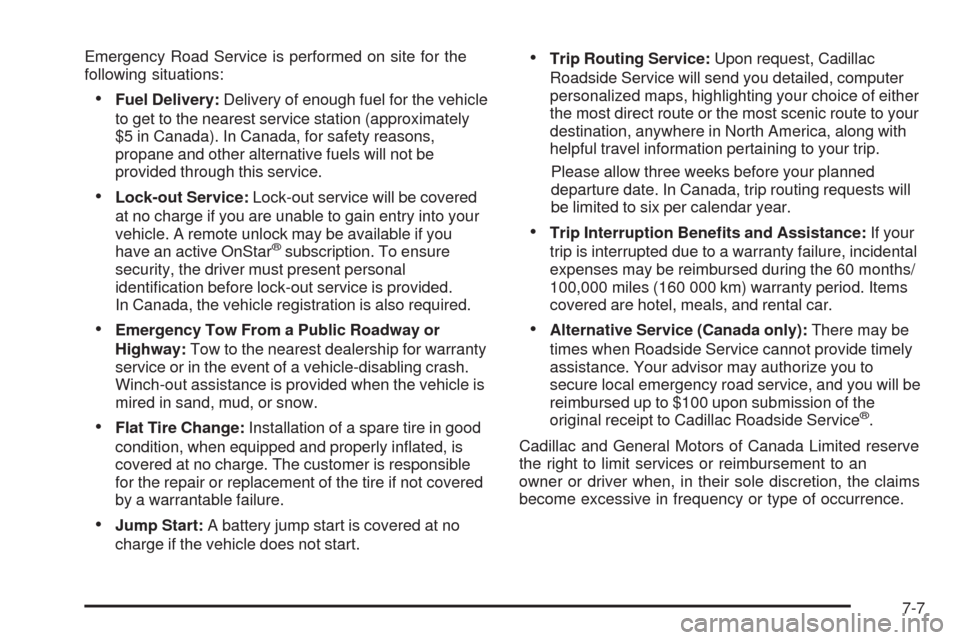
Emergency Road Service is performed on site for the
following situations:
Fuel Delivery:Delivery of enough fuel for the vehicle
to get to the nearest service station (approximately
$5 in Canada). In Canada, for safety reasons,
propane and other alternative fuels will not be
provided through this service.
Lock-out Service:Lock-out service will be covered
at no charge if you are unable to gain entry into your
vehicle. A remote unlock may be available if you
have an active OnStar
®subscription. To ensure
security, the driver must present personal
identi�cation before lock-out service is provided.
In Canada, the vehicle registration is also required.
Emergency Tow From a Public Roadway or
Highway:Tow to the nearest dealership for warranty
service or in the event of a vehicle-disabling crash.
Winch-out assistance is provided when the vehicle is
mired in sand, mud, or snow.
Flat Tire Change:Installation of a spare tire in good
condition, when equipped and properly in�ated, is
covered at no charge. The customer is responsible
for the repair or replacement of the tire if not covered
by a warrantable failure.
Jump Start:A battery jump start is covered at no
charge if the vehicle does not start.
Trip Routing Service:Upon request, Cadillac
Roadside Service will send you detailed, computer
personalized maps, highlighting your choice of either
the most direct route or the most scenic route to your
destination, anywhere in North America, along with
helpful travel information pertaining to your trip.
Please allow three weeks before your planned
departure date. In Canada, trip routing requests will
be limited to six per calendar year.
Trip Interruption Bene�ts and Assistance:If your
trip is interrupted due to a warranty failure, incidental
expenses may be reimbursed during the 60 months/
100,000 miles (160 000 km) warranty period. Items
covered are hotel, meals, and rental car.
Alternative Service (Canada only):There may be
times when Roadside Service cannot provide timely
assistance. Your advisor may authorize you to
secure local emergency road service, and you will be
reimbursed up to $100 upon submission of the
original receipt to Cadillac Roadside Service
®.
Cadillac and General Motors of Canada Limited reserve
the right to limit services or reimbursement to an
owner or driver when, in their sole discretion, the claims
become excessive in frequency or type of occurrence.
7-7
Page 485 of 500
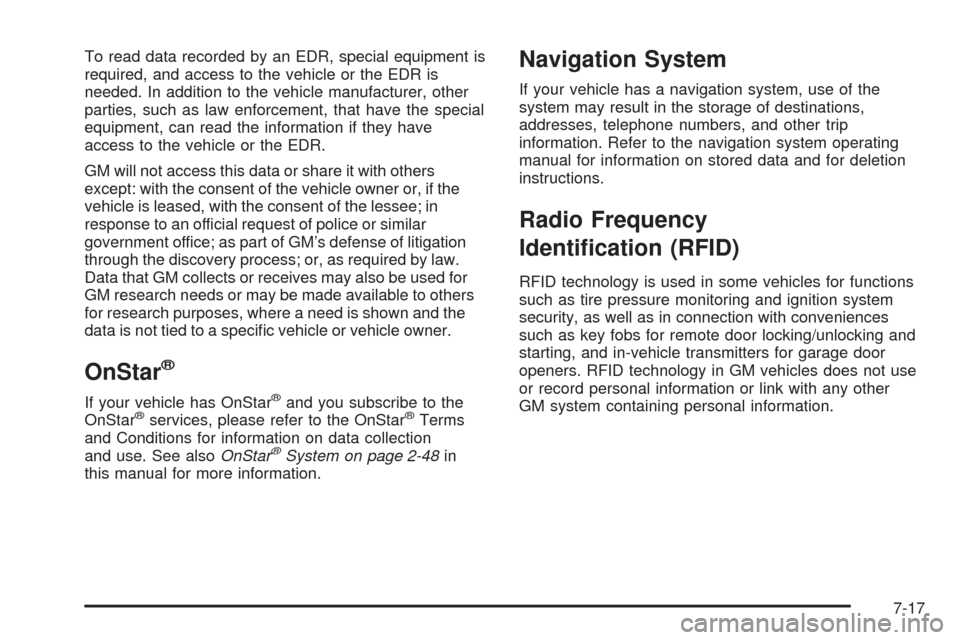
To read data recorded by an EDR, special equipment is
required, and access to the vehicle or the EDR is
needed. In addition to the vehicle manufacturer, other
parties, such as law enforcement, that have the special
equipment, can read the information if they have
access to the vehicle or the EDR.
GM will not access this data or share it with others
except: with the consent of the vehicle owner or, if the
vehicle is leased, with the consent of the lessee; in
response to an official request of police or similar
government office; as part of GM’s defense of litigation
through the discovery process; or, as required by law.
Data that GM collects or receives may also be used for
GM research needs or may be made available to others
for research purposes, where a need is shown and the
data is not tied to a speci�c vehicle or vehicle owner.
OnStar®
If your vehicle has OnStar®and you subscribe to the
OnStar®services, please refer to the OnStar®Terms
and Conditions for information on data collection
and use. See alsoOnStar
®System on page 2-48in
this manual for more information.
Navigation System
If your vehicle has a navigation system, use of the
system may result in the storage of destinations,
addresses, telephone numbers, and other trip
information. Refer to the navigation system operating
manual for information on stored data and for deletion
instructions.
Radio Frequency
Identi�cation (RFID)
RFID technology is used in some vehicles for functions
such as tire pressure monitoring and ignition system
security, as well as in connection with conveniences
such as key fobs for remote door locking/unlocking and
starting, and in-vehicle transmitters for garage door
openers. RFID technology in GM vehicles does not use
or record personal information or link with any other
GM system containing personal information.
7-17
Page 496 of 500
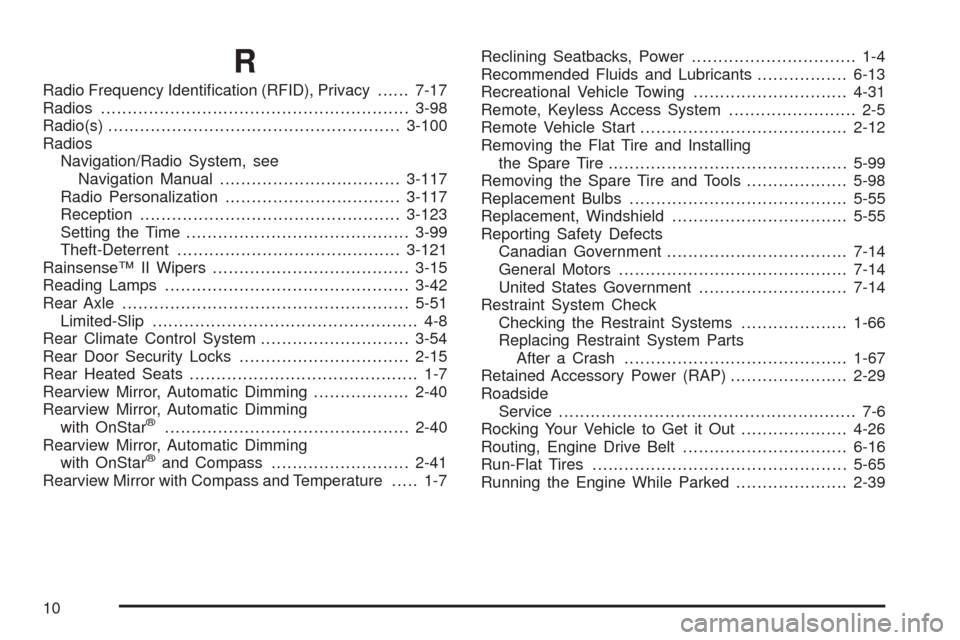
R
Radio Frequency Identi�cation (RFID), Privacy......7-17
Radios..........................................................3-98
Radio(s).......................................................3-100
Radios
Navigation/Radio System, see
Navigation Manual..................................3-117
Radio Personalization.................................3-117
Reception.................................................3-123
Setting the Time..........................................3-99
Theft-Deterrent..........................................3-121
Rainsense™ II Wipers.....................................3-15
Reading Lamps..............................................3-42
Rear Axle......................................................5-51
Limited-Slip.................................................. 4-8
Rear Climate Control System............................3-54
Rear Door Security Locks................................2-15
Rear Heated Seats........................................... 1-7
Rearview Mirror, Automatic Dimming..................2-40
Rearview Mirror, Automatic Dimming
with OnStar
®..............................................2-40
Rearview Mirror, Automatic Dimming
with OnStar
®and Compass..........................2-41
Rearview Mirror with Compass and Temperature..... 1-7Reclining Seatbacks, Power............................... 1-4
Recommended Fluids and Lubricants.................6-13
Recreational Vehicle Towing.............................4-31
Remote, Keyless Access System........................ 2-5
Remote Vehicle Start.......................................2-12
Removing the Flat Tire and Installing
the Spare Tire.............................................5-99
Removing the Spare Tire and Tools...................5-98
Replacement Bulbs.........................................5-55
Replacement, Windshield.................................5-55
Reporting Safety Defects
Canadian Government..................................7-14
General Motors...........................................7-14
United States Government............................7-14
Restraint System Check
Checking the Restraint Systems....................1-66
Replacing Restraint System Parts
After a Crash..........................................1-67
Retained Accessory Power (RAP)......................2-29
Roadside
Service........................................................ 7-6
Rocking Your Vehicle to Get it Out....................4-26
Routing, Engine Drive Belt...............................6-16
Run-Flat Tires................................................5-65
Running the Engine While Parked.....................2-39
10
Page 497 of 500
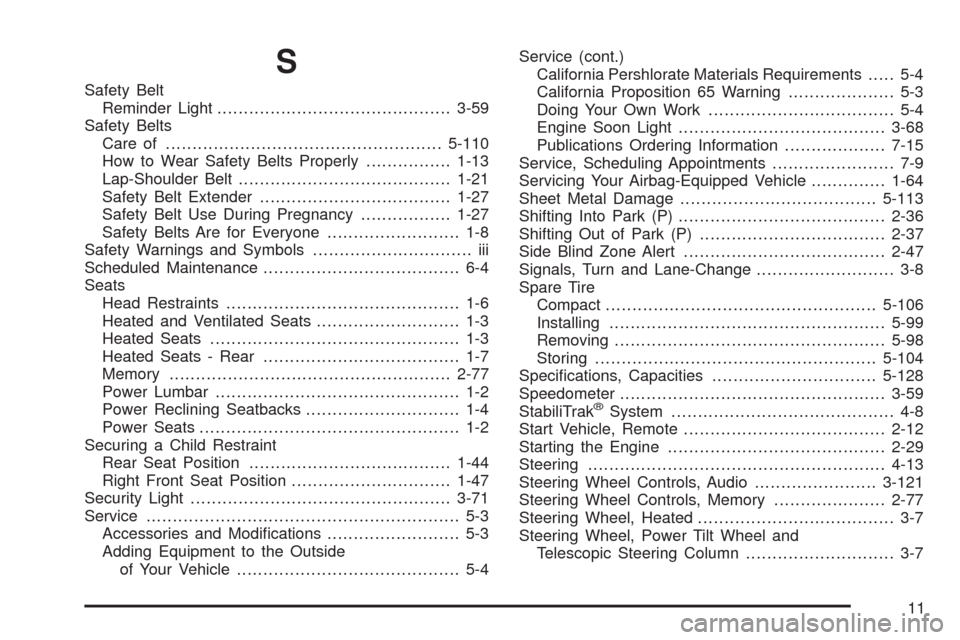
S
Safety Belt
Reminder Light............................................3-59
Safety Belts
Care of....................................................5-110
How to Wear Safety Belts Properly................1-13
Lap-Shoulder Belt........................................1-21
Safety Belt Extender....................................1-27
Safety Belt Use During Pregnancy.................1-27
Safety Belts Are for Everyone......................... 1-8
Safety Warnings and Symbols.............................. iii
Scheduled Maintenance..................................... 6-4
Seats
Head Restraints............................................ 1-6
Heated and Ventilated Seats........................... 1-3
Heated Seats............................................... 1-3
Heated Seats - Rear..................................... 1-7
Memory.....................................................2-77
Power Lumbar.............................................. 1-2
Power Reclining Seatbacks............................. 1-4
Power Seats................................................. 1-2
Securing a Child Restraint
Rear Seat Position......................................1-44
Right Front Seat Position..............................1-47
Security Light.................................................3-71
Service........................................................... 5-3
Accessories and Modi�cations......................... 5-3
Adding Equipment to the Outside
of Your Vehicle.......................................... 5-4Service (cont.)
California Pershlorate Materials Requirements..... 5-4
California Proposition 65 Warning.................... 5-3
Doing Your Own Work................................... 5-4
Engine Soon Light.......................................3-68
Publications Ordering Information...................7-15
Service, Scheduling Appointments....................... 7-9
Servicing Your Airbag-Equipped Vehicle..............1-64
Sheet Metal Damage.....................................5-113
Shifting Into Park (P).......................................2-36
Shifting Out of Park (P)...................................2-37
Side Blind Zone Alert......................................2-47
Signals, Turn and Lane-Change.......................... 3-8
Spare Tire
Compact...................................................5-106
Installing....................................................5-99
Removing
...................................................5-98
Storing.....................................................5-104
Speci�cations, Capacities...............................5-128
Speedometer..................................................3-59
StabiliTrak
®System.......................................... 4-8
Start Vehicle, Remote......................................2-12
Starting the Engine.........................................2-29
Steering........................................................4-13
Steering Wheel Controls, Audio.......................3-121
Steering Wheel Controls, Memory.....................2-77
Steering Wheel, Heated..................................... 3-7
Steering Wheel, Power Tilt Wheel and
Telescopic Steering Column............................ 3-7
11
Page 499 of 500
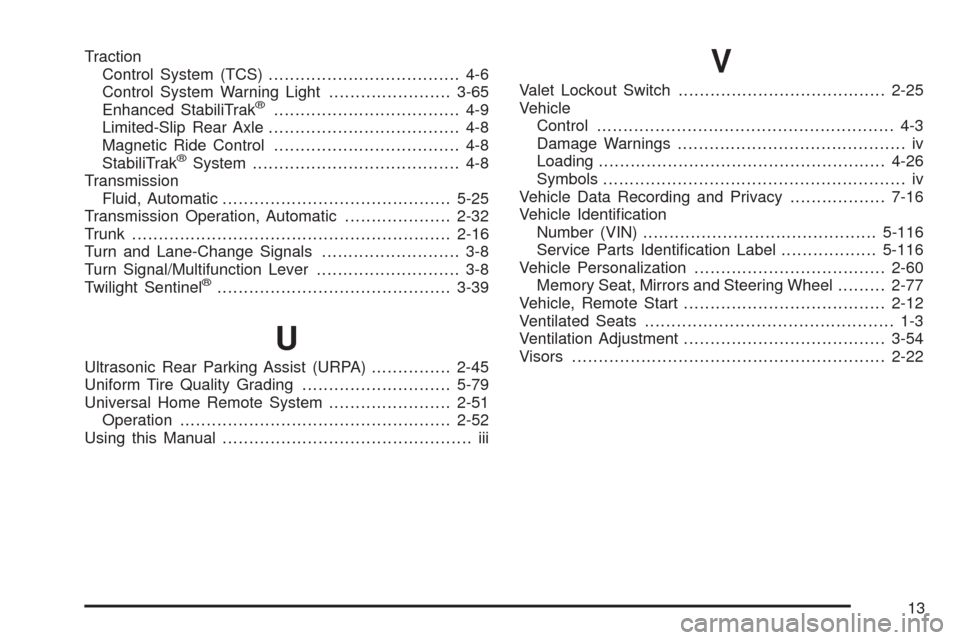
Traction
Control System (TCS).................................... 4-6
Control System Warning Light.......................3-65
Enhanced StabiliTrak
®................................... 4-9
Limited-Slip Rear Axle.................................... 4-8
Magnetic Ride Control................................... 4-8
StabiliTrak
®System....................................... 4-8
Transmission
Fluid, Automatic...........................................5-25
Transmission Operation, Automatic....................2-32
Trunk............................................................2-16
Turn and Lane-Change Signals.......................... 3-8
Turn Signal/Multifunction Lever........................... 3-8
Twilight Sentinel
®............................................3-39
U
Ultrasonic Rear Parking Assist (URPA)...............2-45
Uniform Tire Quality Grading............................5-79
Universal Home Remote System.......................2-51
Operation...................................................2-52
Using this Manual............................................... iii
V
Valet Lockout Switch.......................................2-25
Vehicle
Control........................................................ 4-3
Damage Warnings........................................... iv
Loading......................................................4-26
Symbols......................................................... iv
Vehicle Data Recording and Privacy..................7-16
Vehicle Identi�cation
Number (VIN)............................................5-116
Service Parts Identi�cation Label..................5-116
Vehicle Personalization....................................2-60
Memory Seat, Mirrors and Steering Wheel.........2-77
Vehicle, Remote Start......................................2-12
Ventilated Seats............................................... 1-3
Ventilation Adjustment......................................3-54
Visors...........................................................2-22
13